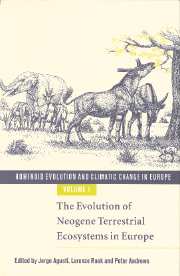Book contents
- Frontmatter
- Contents
- List of contributors
- Acknowledgements: The European Science Foundation
- 1 Introduction
- PART I Palaeogeography of the circum-Mediterranean region
- 2 Mediterranean and Paratethys Palaeogeography during the Oligocene and Miocene
- 3 Pliocene tephra correlations between East African hominid localities, the Gulf of Aden, and the Arabian Sea
- 4 Climatic perspectives for Neogene environmental reconstructions
- PART II Miocene mammalian successions
- PART III Palaeoenvironments: non-mammalian evidence
- PART IV Palaeoenvironments: mammalian evidence
- Index
2 - Mediterranean and Paratethys Palaeogeography during the Oligocene and Miocene
from PART I - Palaeogeography of the circum-Mediterranean region
Published online by Cambridge University Press: 15 December 2009
- Frontmatter
- Contents
- List of contributors
- Acknowledgements: The European Science Foundation
- 1 Introduction
- PART I Palaeogeography of the circum-Mediterranean region
- 2 Mediterranean and Paratethys Palaeogeography during the Oligocene and Miocene
- 3 Pliocene tephra correlations between East African hominid localities, the Gulf of Aden, and the Arabian Sea
- 4 Climatic perspectives for Neogene environmental reconstructions
- PART II Miocene mammalian successions
- PART III Palaeoenvironments: non-mammalian evidence
- PART IV Palaeoenvironments: mammalian evidence
- Index
Summary
Introduction
The Cenozoic configuration of continents and oceans is strongly influenced by plate tectonic movements. Opening and closing pathways for mammal migrations and marine exchanges are one of the triggering forces for faunal events and evolution. The impacts of a vanishing Tethys Ocean in the mid-Cenozoic are not only important for the marine and continental biotas of Eurasia and the Mediterranean, but also influenced the environmental conditions worldwide. The dispersal of continents in the Southern Hemisphere with the northward movement of the Indian and Australian continents, together with the counterclockwise rotation of Africa, closed down the Tethys Ocean. Parallel to these movements the Atlantic Ocean opened. The Mesozoic oceanic circulation patterns changed to varying conditions with decreasing temperatures in the Cenozoic. Based on oxygen isotopes (Kennett, 1995), bottom water temperatures were highest in the late Palaeocene–early Eocene (c. 55 Ma). Distinct steps to colder conditions followed around the Eocene/Oligocene boundary (33–35 Ma), in the middle Miocene (15 Ma), and in the Pliocene (3 Ma).
Different palaeogeographic reconstructions over the past two decades have attempted to solve the development of the Cenozoic Mediterranean and Paratethys areas. In many cases these reconstructions depend on the present sediment distribution and do not consider palinspastic reconstructions based on plate tectonic movements (e.g. Vinogradov, 1967–69; Senes & Marinescu, 1974; Steininger et al., 1985a; Hamor & Halmai, 1988; Cahuzac et al., 1992; Popov et al., 1993). Other reconstructions include too long a time span within one time slice to present a distinct time level within a strongly changing environment (e.g. Biju-Duval et al., 1977; Dercourt et al., 1985, 1993).
- Type
- Chapter
- Information
- Hominoid Evolution and Climatic Change in Europe , pp. 8 - 22Publisher: Cambridge University PressPrint publication year: 1999
- 38
- Cited by



